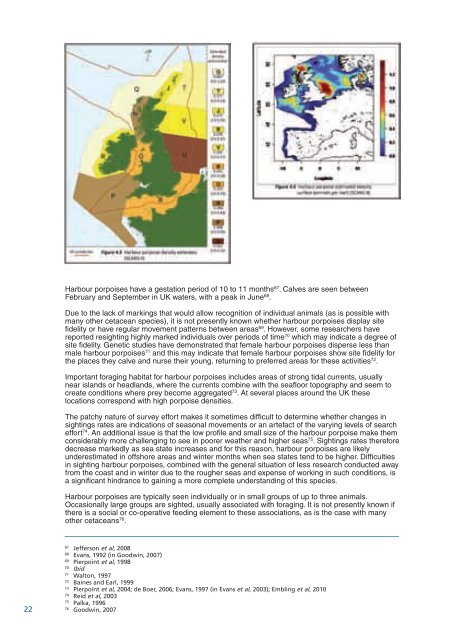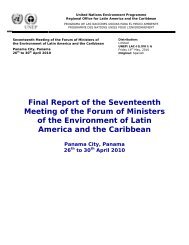Harbour porpoises have a gestation period of 10 to 11 months 67 . Calves are seen betweenFebruary and September in UK waters, with a peak in June 68 .Due to the lack of markings that would allow recognition of individual animals (as is possible withmany other cetacean species), it is not presently known whether harbour porpoises display sitefidelity or have regular movement patterns between areas 69 . However, some researchers havereported resighting highly marked individuals over periods of time 70 which may indicate a degree ofsite fidelity. Genetic studies have demonstrated that female harbour porpoises disperse less thanmale harbour porpoises 71 and this may indicate that female harbour porpoises show site fidelity forthe places they calve and nurse their young, returning to preferred areas for these activities 72 .Important foraging habitat for harbour porpoises includes areas of strong tidal currents, usuallynear islands or headlands, where the currents combine with the seafloor topography and seem tocreate conditions where prey become aggregated 73 . At several places around the UK theselocations correspond with high porpoise densities.The patchy nature of survey effort makes it sometimes difficult to determine whether changes insightings rates are indications of seasonal movements or an artefact of the varying levels of searcheffort 74 . An additional issue is that the low profile and small size of the harbour porpoise make themconsiderably more challenging to see in poorer weather and higher seas 75 . Sightings rates thereforedecrease markedly as sea state increases and for this reason, harbour porpoises are likelyunderestimated in offshore areas and winter months when sea states tend to be higher. Difficultiesin sighting harbour porpoises, combined with the general situation of less research conducted awayfrom the coast and in winter due to the rougher seas and expense of working in such conditions, isa significant hindrance to gaining a more complete understanding of this species.Harbour porpoises are typically seen individually or in small groups of up to three animals.Occasionally large groups are sighted, usually associated with foraging. It is not presently known ifthere is a social or co-operative feeding element to these associations, as is the case with manyother cetaceans 76 .2267Jefferson et al, 200868Evans, 1992 (in Goodwin, 2007)69Pierpoint et al, 199870Ibid71Walton, 199772Baines and Earl, 199973Pierpoint et al, 2004; de Boer, 2006; Evans, 1997 (in Evans et al, 2003); Embling et al, 201074Reid et al, 200375Palka, 199676Goodwin, 2007
Although there is some variation in prey depending on area, season and age of the porpoise,dietary studies have found that sandeels (Ammodytes marinus) are the most important preyspecies for north east Atlantic harbour porpoises during the spring and summer, and whiting(Merlangius merlangus) in the autumn and winter months 77 . These will be supplemented withother fish such as herring (Clupea harengus), mackerel (Scomber scombrus) and gobies(Pomatoschistus sp.) throughout the year.Anatomical and genetic studies on harbour porpoises to elucidate population structure haveindicated that several populations and subpopulations exist in the North Atlantic. In UK waters,work suggests that genetically differentiated subpopulations exist in the Irish Sea/Wales and theNorth Sea, with some possible further divisions of the North Sea population 78 .Understanding population structure is important for conservation efforts. It is likely that the effectsof regional threats such as bycatch will be underestimated if animals are thought to be part of asingle, wider population but actually form discrete subpopulations 79 .See Annex II for summary tables with information from the individual papers used.West and south west ScotlandSeveral studies have shown west Scotland, and especially the Hebrides, to be of particularimportance to harbour porpoises 80 . The SCANS II survey which took place in July 2005, recordedone of the highest densities of harbour porpoises in the north east Atlantic for the Hebrides, at0.394 animals/km 2 (see Figure 4.5, p.22). Other density estimates produced in the region coveredtwo smaller areas, the Inner Hebrides and the Firth of Clyde (see Figure 4.7, below), again for thesummer months. A very high density estimate of 1.071 animals/km 2 was reported for the InnerHebrides, an area frequently reported to host concentrations of harbour porpoises 81 . The samestudy also recorded a high density of porpoises for the Firth of Clyde, 0.823 animals/km 2 . Thereare much less data available for the Firth of Clyde compared to the Inner Hebrides, but this highdensity estimate suggests it may also be of importance for harbour porpoises. High densities ofharbour porpoises during the summer, the time of year when these animals breed andproduce young, suggests these waters may be important for these functions. This shouldbe investigated further.77Santos and Pierce, 200378Anderson et al, 2001; Walton, 199779Anderson et al, 2001; Walton, 199780Including Evans and Wang, 2002; Northridge et al, 199581Pollock et al, 2000; Embling et al, 2010; Marubini et al, 2009; Evans and Wang, 200223
- Page 1 and 2: WDCS, the Whale and Dolphin Conserv
- Page 3 and 4: Towards Marine ProtectedAreas for C
- Page 5 and 6: South west EnglandCeltic Deep - com
- Page 7 and 8: CONTENTSExecutive Summary 2Acknowle
- Page 9 and 10: 1. INTRODUCTIONWe enter an exciting
- Page 11 and 12: Note: This schematic map shows thev
- Page 13 and 14: 2. IDENTIFYING MARINE PROTECTED ARE
- Page 15 and 16: 3. CRITICAL HABITATInterest in the
- Page 17 and 18: Foraging, travel, socialising and p
- Page 19 and 20: 4. DATA AND SPECIES ACCOUNTSIn orde
- Page 21 and 22: Killer whale (Orcinus orca)Atlantic
- Page 23: 4.4 SPECIES ACCOUNTS4.4.1 HARBOUR P
- Page 27 and 28: North ScotlandThe first SCANS surve
- Page 29 and 30: East EnglandThe seasonal pattern in
- Page 31 and 32: Irish SeaOutside of coastal Welsh w
- Page 33 and 34: 4.4.2 BOTTLENOSE DOLPHIN (Tursiops
- Page 35 and 36: This expansion in range means this
- Page 37 and 38: 4.4.3 SHORTBEAKED COMMON DOLPHIN (D
- Page 39 and 40: South west EnglandBased on observat
- Page 41 and 42: 4.4.4 COMMON MINKE WHALE (Balaenopt
- Page 43 and 44: Sightings for this area of the Oute
- Page 45 and 46: The JNCC Atlas of cetacean distribu
- Page 47 and 48: 4.4.5 WHITEBEAKED DOLPHIN (Lagenorh
- Page 49 and 50: 4.4.6 RISSO'S DOLPHIN (Grampus gris
- Page 51 and 52: 4.4.7 KILLER WHALE OR ORCA (Orcinus
- Page 53 and 54: 4.4.8 ATLANTIC WHITESIDED DOLPHIN (
- Page 55 and 56: 4.4.9 LONGFINNED PILOT WHALE (Globi
- Page 57 and 58: 4.4.10 SPERM WHALE (Physeter macroc
- Page 59 and 60: 4.4.11 BEAKED WHALESNORTHERN BOTTLE
- Page 61 and 62: which looked at worldwide beaked wh
- Page 63 and 64: There is no current population esti
- Page 65 and 66: 4.5 SCOTTISH MPA GUIDELINES - STAGE
- Page 67 and 68: Northern bottlenose whale and Sower
- Page 69 and 70: Fisheries BycatchFisheries bycatch
- Page 71 and 72: 5.2 AN OVERVIEW OF REGIONAL THREATS
- Page 73 and 74: North ScotlandAs in the west, threa
- Page 75 and 76:
6. IDENTIFYING CRITICAL HABITAT IN
- Page 77 and 78:
6.1.1 HARBOUR PORPOISEWest and sout
- Page 79 and 80:
Assessment: Critical HabitatHigh re
- Page 81 and 82:
11. Area: Off Land's End, Cornwall
- Page 83 and 84:
Threats, status and relative import
- Page 85 and 86:
East Scotland3. Area: North east Sc
- Page 87 and 88:
Threats, status and relative import
- Page 89 and 90:
6.1.4 COMMON MINKE WHALEWest and so
- Page 91 and 92:
6.1.5 WHITEBEAKED DOLPHINWest and s
- Page 93 and 94:
Coastal Wales2. Area: Bardsey Islan
- Page 95 and 96:
6.1.8 ATLANTIC WHITESIDED DOLPHINNo
- Page 97 and 98:
Other areasOne other area was asses
- Page 99 and 100:
6.1.11 BEAKED WHALESThe northern Ro
- Page 101 and 102:
7. PROTECTING CRITICAL HABITAT - RE
- Page 103 and 104:
considered in the area, each of whi
- Page 105 and 106:
7.4 EAST SCOTLANDWithin the east Sc
- Page 107 and 108:
7.5 SOUTH WEST ENGLANDWithin the so
- Page 109 and 110:
An SAC is already in place for bott
- Page 111 and 112:
7.9 SUMMARYFour areas of identified
- Page 113 and 114:
iv. Licensing processes for industr
- Page 115 and 116:
9. IDENTIFICATION AND PRIORITISATIO
- Page 117 and 118:
Recommendations on particular data
- Page 119 and 120:
Coastal Wales northern Pembrokeshir
- Page 121 and 122:
ANNEX II SPECIES ACCOUNTS SUMMARY
- Page 123 and 124:
HARBOUR PORPOISEEast ScotlandStudyH
- Page 125 and 126:
HARBOUR PORPOISESouth West EnglandS
- Page 127 and 128:
HARBOUR PORPOISECoastal WalesStudyT
- Page 129 and 130:
BOTTLENOSE DOLPHINStudyTemporalReso
- Page 131 and 132:
SHORTBEAKED COMMON DOLPHINStudyTemp
- Page 133 and 134:
SHORTBEAKED COMMON DOLPHINStudyTemp
- Page 135 and 136:
COMMON MINKE WHALEWest ScotlandStud
- Page 137 and 138:
WHITEBEAKED DOLPHINStudyTemporalRes
- Page 139 and 140:
KILLER WHALEStudyTemporalResolution
- Page 141 and 142:
ATLANTIC WHITESIDED DOLPHINStudyTem
- Page 143 and 144:
SPERM WHALEStudyTemporalResolutionS
- Page 145 and 146:
BALEEN WHALESStudyTemporalResolutio
- Page 147 and 148:
ANNEX III THREATS TO CETACEANS - RE
- Page 149 and 150:
Actual orPotential ThreatActivitySp
- Page 151:
North ScotlandSpecies of most relev
- Page 156 and 157:
East EnglandSpecies of most relevan
- Page 158 and 159:
South East EnglandSpecies of most r
- Page 160 and 161:
South West EnglandSpecies of most r
- Page 162 and 163:
Irish SeaSpecies of most relevance
- Page 164 and 165:
Actual orPotential ThreatActivitySp
- Page 166 and 167:
Bravington, M., Borchers, D. and No
- Page 168 and 169:
Evans, P.G.H. and Anderwald, P. 200
- Page 170 and 171:
ICES WGMME. 2006. Report of the Wor
- Page 172 and 173:
ECS/ASCOBANS/ACCOBAMS Workshop held
- Page 174 and 175:
marine protected areas effective to
- Page 176:
ISBN: 9781901386233
















